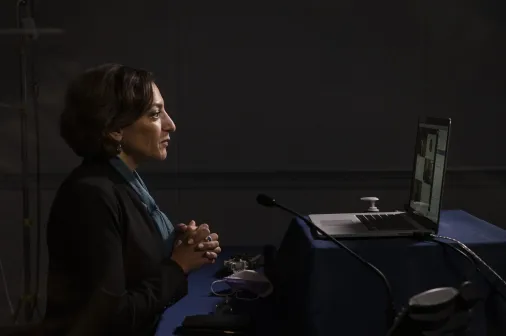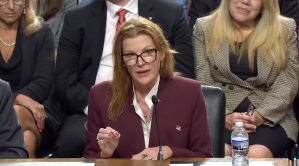Pentagon CIO working on new program to break down disparate IT networks

The Pentagon’s chief information officer is undertaking yet another reform of the Defense Department’s IT enterprise — this time focusing on streamlining its classified networks to enhance data sharing and interoperability.
Katie Arrington, who is performing the duties of CIO, plans to introduce a new program dubbed “Mission Network-as-a-Service” that aims to reduce the number of disparate data fabrics used by combatant commands into a single, unified network. Speaking on Thursday during the Billington Cybersecurity Summit, Arrington said the program will be key to realizing the department’s vision for Combined Joint All-Domain Command and Control (CJADC2).
Broadly speaking, CJADC2 seeks to connect the U.S. military’s sensors and weapons under a single network, enabling rapid data transfer between warfighting systems and domains. The Pentagon also wants to be able to quickly share relevant information with international partners and allies during conflicts, adding another layer of difficulty to realizing the construct.
“I need one fabric where I can view command and control. I need sensors and shooters, and I need the data in those environments to be so that my allies and partners can use them, but not to the degree that I do,” she said. “If I’m fighting a war in Taiwan [or] the first island chain, I want South Korea to get that they need a target based at this latitude and this longitude. But what I really don’t want to give is the whole ball of wax.”
Mission Network-as-a-Service is the latest program from the Pentagon CIO focused on streamlining the department’s IT enterprise as a way to cut back on unnecessary spending. The effort aligns closely with others recently spearheaded by Arrington, including the Software Fast Track (SWFT) program and the Risk Management Framework Revamp initiative.
Arrington noted that each COCOM can have anywhere up to 20 siloed networks, creating complexity and issues when trying to share data. The Mission Network-as-a-Service program will attempt to collapse data fabrics used across the combatant commands into a joint secret-level environment built on commercial cloud systems at Impact Level 2.
“I can run on an IL2 environment, and as the data goes up it traverses into my secret fabric. It’s only the particular pieces of data that I need that actually make it secret, and it’s only me … that needs to see that information. When I micro-segment up into another level, and I bring in other data points, it becomes top secret,” Arrington explained.
Many of the capabilities that will enable the Pentagon’s shift to operating under a zero-trust architecture will be linchpins for Mission Network-as-a-Service. The cybersecurity framework assumes that adversaries are already moving through IT networks, and therefore requires organizations to continuously monitor and validate users and their devices as they move through the network.
To that end, Mission Network-as-a-Service will rely on accurate data labelling and data tagging, as well as a federated identity, credential and access management (ICAM) — which the Pentagon hopes to have by the end of 2025. ICAM comprises a set of IT policies, systems and security tools that verify users have the right credentials to access specific parts of a network.
“When I’m in my office in the Pentagon, I need the capability with my [Common Access Card]. If I need to go fight in [U.S. Central Command], I need to be able to use that same identity in Centcom at the time of relevance — not the time of traversing and creating a new network,” Arrington said. “That’s what we’re all about, and that’s what zero trust is giving us.”






